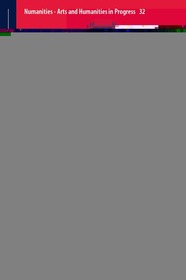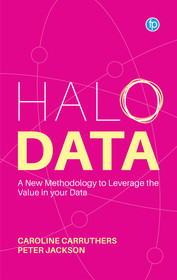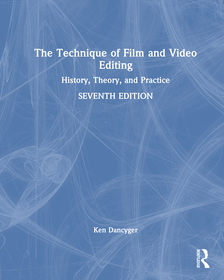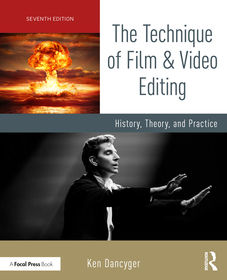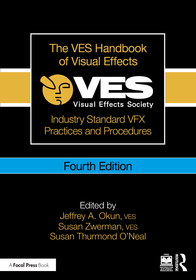
The VES Handbook of Visual Effects
Industry Standard VFX Practices and Procedures
- Publisher's listprice GBP 64.99
-
31 048 Ft (29 570 Ft + 5% VAT)
The price is estimated because at the time of ordering we do not know what conversion rates will apply to HUF / product currency when the book arrives. In case HUF is weaker, the price increases slightly, in case HUF is stronger, the price goes lower slightly.
- Discount 10% (cc. 3 105 Ft off)
- Discounted price 27 944 Ft (26 613 Ft + 5% VAT)
Subcribe now and take benefit of a favourable price.
Subscribe
31 048 Ft

Availability
Not yet published.
Why don't you give exact delivery time?
Delivery time is estimated on our previous experiences. We give estimations only, because we order from outside Hungary, and the delivery time mainly depends on how quickly the publisher supplies the book. Faster or slower deliveries both happen, but we do our best to supply as quickly as possible.
Product details:
- Edition number 4
- Publisher Routledge
- Date of Publication 18 December 2025
- ISBN 9781032853697
- Binding Paperback
- No. of pages878 pages
- Size 254x178 mm
- Language English
- Illustrations 30 Illustrations, black & white; 280 Illustrations, color; 30 Halftones, black & white; 280 Halftones, color; 3 Tables, color 700
Categories
Short description:
_bookmark126" target="_blank">Camera Report
Tracking Markers
Props for the Actors
Cyberscanning
Digital Photos
LiDAR/Laser Scanning
Lens Distortion Charts
HDRI and Chrome Balls
LiDAR Scanning and Acquisition - Alan Lasky
On-Set 3D Scanning Systems - Joshua DeHerrera
Types of Technology
LiDAR
Photogrammetry
Prop Scanners
Lighting Data - Charles Clavadetscher, Jeffrey A. Okun, VES
Gathering Lighting Data
Using Conventional Still Cameras
Reference Shooting Considerations
Beware of False Savings!
Clean Plates - Scott Squires, VES
Shooting the Clean Plate
Locked-Off Camera
Moving Camera
Other Issues
Post-Process
Alternates without Clean Plates
Other Uses for Clean Plates
Monster Sticks - Scott Squires, VES
On-Set Animation Capture: Witness Cam (IBMC) - Joel Hynek
Wireless Non-Video Motion Capture
Factors Affecting Witness Cameras
Dealing with the Data in Post-Production
Camera Tracking for Real-Time Visualization - Joe Lewis
Introduction
Camera Department: Pre-Production and Cooperation
Camera Tracking Strategies in an LED Volume
Emerging, Innovation and Mature Technology
Triangulation As a Method of Recording Camera Data - Stuart Robertson
Camera/Subject Positional Information
Basics: The Toolkit
Basics: Nodal Point
Photographic Reference - Charles Clavadetscher
How to Proceed
Shooting Video as a Reference
Rules, Setup, and Testing - Charles Clavadetscher
Do a Complete Test Shot!
Why Run Through Example or Test Shots?
Digital Cinematography - David Stump, ASC, Marty Ollstein, David Reisner, W. Thomas Wolf
Digital Definitions
High Dynamic Range (HDR)
Camera / Lens Metadata
Camera Tracking
Look Management
The Recording System
VFX Photography - Eric Swenson
The Camera Array
Designing an Array Shot
Technicians
Shoot Day
Special Techniques
Post
The Future
Filming Live-Action Plates to be Used in VFX - Bill Taylor, ASC, VES
Camera Position (Station Point)
Angle of View
Lighting Considerations
Camera Tilt
Background Quality
Moving Plates
Scouting the Camera Positions
A Case Study
Camera Cars
Camera Car Safety Issues
Purpose-Built Crane Cars
Vibration and Camera Stabilization
Road Speed
Precautions
Panoramic Rigs
On the Water
Air to Air
Cable Systems
Shooting Elements for Compositing - Mark H. Weingartner
What Is an Element?
Stock Footage
Types of Elements
Generic versus Shot-Specific Elements
Determining Element Needs
Cheating
Backgrounds
Black Backgrounds
Line-Up
Camera Format Considerations
Assorted Methods for Shooting Elements
High-Speed Cinematography and Filming Elements - Jim Matlosz
Cameras
Technicians
Director of Photography
Lighting
Moving the Camera
Video Assist
Post
Supervising Motion Control - Mark Weingartner
What is Motion Control?
Performance Choreography
Multiple-Pass Photography
Scaling
Import and Export of Camera Move Data
The Data
Types of Motion Control Systems
Motion Control Software
Camera Types
Sync and Phase
Dealing with Production
Acquisition of Motion / Still Photographic Textures for Mapping onto CG - Mark Weingartner
Panoramic Backgrounds
Tiled Stills
Motion Tiling and Synchronous Plates
Practical Considerations
Stills for Textures and Lighting
Stop-Motion - Pete Kozachik, ASC
Evolution of Stop-Motion Photography
The Time Required to Shoot in Stop-Motion
Preparation before Shooting
Setting up a Shooting Space for Stop-Motion
Use of Motion Control in Stop-Motion
Useful Caveats
Evolution of a Shot
Use of Stop-Motion in Visual Effects
CHAPTER 4: PERFORMANCE AND MOTION CAPTURE
Defining Motion Capture / Performance Capture - Demian Gordon, Nathan Camp, John Root
How Motion Capture is Used Across the Industry - Demian Gordon, Nathan Camp, John Root
Is Motion Capture Right for a Project? – Demian Gordon, Nathan Camp, John Root, Tracy McSherry
The Mocap Look
Visual Storytelling and Aesthetic
Production Planning
Performance
Technology and Approach
Aligning Needs vs. Wants
Optical Motion Capture
Motion Capture for Virtual Production
Motion Capture for Animation
Production Planning Scenarios for Motion Capture – Demian Gordon, Nathan Camp, Rhea Aylin Fischer,
and John Root
Subject Matter of the Shoot
Performance and Actor Considerations
Real-Time Presentation
Subjects Being Captured
Volume Size and Build
Syncing Hardware and Software
Rigging and Retargeting for Motion Capture
Shot List
Client or Vendor Delivery
Optical Motion Capture – Nathan Camp, Demian Gordon , John Root
Technical and Approach
Entry Point
Budget
Hardware
Software
Inertial Motion Capture - Rhea Aylin Fischer, Ted O’Brien ,John Root, and Demian Gordon
Use Cases
Technology and Approach
Entry Point
Budget
Hardware
Software
Motion Capture for Virtual Production - Nathan Camp, Ted O'Brien
Use Cases
Technology and Approach
Entry Point
Budget
Hardware
Software
Hand Capture Demian Gordon , Rhea Aylin Fischer, Tracy McSherry. John Root,
Use Cases
Advantages and Disadvantages
Technology and Approach
Budget
Facial Motion Capture – John Root, Demian Gordon, Gareth Edwards, and Oleg Alexander
Use Cases
Markerset
Lighting
Facial Hair
Advantages and Disadvantages
Entry Point
Budget
Facial Actor Survey
Actor Survey - Hardware
Applying AI
Volumetric Capture / Considerations for Production - Wardrobe, Hair, Makeup, and Blocking - Christina Heller, Skylar Sweetman, Mari Young
CHAPTER 5: VIRTUAL PRODUCTION AND AI TOOLS IN VISUAL EFFECTS
Virtual Production - Addison Bath
What is Virtual Production
How is Virtual Production Used?
Note from the Editors: – Jeffrey A. Okun, VES, Susan Zwerman, VES, Susan Thurmond O’Neal
Capturing Surfaces with Photogrammetry to Create Assets - Luis Cataldi
Introduction
Core Principles of Photogrammetry
Applied Principles of Image Capture for Photogrammetry
Capture Methods and Workflows
Final Thoughts
Photogrammetry and LiDAR Sets for Virtual Production - Tripp Topping
Optimization
The Use of AI in Visual Effects - Lucien Harriot
Introduction
Overview of Generative Artificial Intelligence (GenAI)
Applications of GenAI in Visual Effects
Impact on Visual Effects Processes
Limitations, Challenges, and Ethical Considerations
Future Developments in GenAI
Embracing GenAI as a Tool for Innovation
Summary of Techniques for NeRFs and 3D Gaussian Splatting - Mike Seymour
Introduction
Overview of NeRFs and Gaussian Splatting
Neural Radiance Fields (NeRF)
3D Gaussian Splatting
NeRFs and 3DGS in Combination with Other AI
Limitations, Challenges, and Ethical Considerations
Summary of AI Techniques Used in Visual Effects - Steve Wright
A Brief History
AI for Compositing
Image Enhancement
Visual Effects
Other Features
Adapting to a World with AI
CHAPTER 6: POST-PRODUCTION / IMAGE MANIPULATION
Resolution and Image Format Considerations - Scott Squires
Formats
Transport
Resolution
Academy Color Encoding System (ACES) - Bill Baggelaar, Annie Chang, Steve Tobenkin
Overview
Using ACES in Visual Effects Workflows
ACES Color Space Encoding
Compatibility
Image Compression/File Formats for Post-Production - Florian Kainz, Piotr Stanczyk
Image Encoding
Still Image Compression
Other Lossless Compression Methods
File Formats
Color Management - Joseph Goldstone
The Three Guidelines
Digital Color Image Encodings and Digital Cameras
Color Management at the Desktop
OpenColorIO
Digital Intermediate - Tashi Trieu
Introduction to Digital Intermediates
The Colorist
Tools of the Trade
Emerging Technologies
Grading with Mattes
Communicating Color Through the Visual Effects Pipeline
Visual Effects Plate Grading
The Evolution of Color Grading
Shot/Element Pulls and Delivery to VFX - David H. Tanaka
Introduction
The Lab
“Production” Is to “Lab” as
The Merge
The Handoff
VFX Editorial
The Select
The Pull
VFX Editorial – Greg Hyman, David H. Tanaka
Editing within a Shot: The Art of Precompositing (Precomp)
How It Came To Be
Modern Day Tracking and Disseminating of Information
As the Shot Changes
Wrapping It Up
Editorial Workflow in Feature Animation - David H. Tanaka
Introduction
Editorial Crew Staffing and Structure
Editorial Involvement with Feature Animation Production Stages
Communication With Artists - Eric Durst
Starting
Working with Teams
Working Globally
Reference and Perspective
Shot Production
Communicating with Artists in Other Departments
Completion
Compositing of Live-Action Elements - Steve Wright
Overview
Green/Blue Screen Capture
Pre-Processing the Green Screen
Garbage Mattes
Keying Strategies
Motion Blur and Depth of Field
Spill Suppression
Grain Management
Rotoscoping
Post-Composite Processing
3D Compositing
Inspecting the Comp
Rotoscoping and Paint - Marshall Krasser, Sandy Houston
Rotoscoping
Digital Painting and Plate Reconstruction
Deep Compositing - Steve Wright
What is a Deep Image?
Complex Depth Interactions
The Depth Compositing Edge Problem
The Re-rendering Problem
Deep Compositing and Live Action
Matte Painting/Creative Environments - Craig Barron, VES, Deak Ferrand, John Knoll, and Robert Stromberg
Matte Paintings: Art of the Digital Realm
What Is a Matte Painting?
Matte Painting - Pioneers and History
Visualizing the Matte Painting Shot in Pre-Production
On-Set Supervision for Matte Painting Shots
Basic Skills and Tricks of the Trade
Miniatures and Computer-Generated Sets
Finding the Best Frame
Re-Projected Photo Survey
The Need for Creative Compositing
Digital Environments - Robert Stromberg
Reimagining Artistic Roles in Film: The Rise of the “Environment and Creation Artists”
Virtual Production and Game Engine Technology
Future of the Environment Creation Artist and AI
The Power of Curiosity in Creativity and Innovation
CHAPTER 7 - DIGITAL ELEMENT CREATION
Digital Modeling - Kevin Hudson
Overview: The Importance of Modeling
Types of Modeling
Model Data Types
Development of Models
Modeling for a Production Pipeline
Engineering Aspects for Polygons
Engineering Aspects for NURBS
Rigging and Animation Rigging - Steve Preeg
Rigging: What is It?
Animation Rigging
Deformation Rigging
What Makes a Good Rig for Animation – Felix Balbas
Introduction
User and Uses
Technical Aspects
Technology Restrictions
New Technologies
Texturing and Surfacing - Ron Woodall
The Importance of Texture Painting
Hard Surface Models
Creature Models
Types of Geometry: Their Problems and Benefits
Prepping the Model to Be Painted
Texture Creation
Various Other Map-Driven Effects
Texture Painting in Production
Model Editing
Digital Hair/Fur - Armin Bruderlin, Francois Chardavoine
Hair Generation Process
General Issues and Solutions
Digital Feathers - Armin Bruderlin, Francois Chardavoine
Morphology of Real Feathers
Modeling Digital Feathers
Similarities between Hair and Feathers
Differences between Hair and Feathers
General Geometry Instancing - Armin Bruderlin, Francois Chardavoine
Asset Creation
World Building
Shot Considerations
Dynamics and Simulation - Craig Zerouni, Judith Crow
How is a Simulation Created?
When is Simulation Appropriate?
Tricks and Cheats
Important Considerations
Planning and Preparation
Software Solutions: A Broad Overview of Current Options
Particles - Craig Zerouni
What are Particle Systems?
The Next Step
The Birth of Particles
Creating Effects
Rigid Body Dynamics - Craig Zerouni
How Rigid-Body Dynamics are Created
Potential Problems
Other Issues
Tricks for Getting It Done
Digital Lighting - Andrew Whitehurst
Light in Reality and in Computer Graphics
Case Study of Reality Compared with Simple CG Simulation
Visual Sophistication through Texture Mapping
Physically Derived Shading Models
Beneath the Surface
Goals of Lighting in Visual Effects
Work Flow for Successful Creative Digital Lighting
The Technologies of Lights in Computer Graphics
Direct Lighting: Source to Surface to Camera
Reflections
Photographed Reflections
Shadows
Image-Based Lighting
Rendering Occlusion
Ambient Occlusion
Reflection Occlusion
Creating Light Sources from Environment Maps
Physically Based Rendering
Physically Plausible Rendering
Volumetric Lighting Effects
Shader Basics - Derek Spears
What are Shaders?
Shading Models
Bump and Displacement
Map-Based Shaders
Procedural Shaders
Shader Design
Anti-aliasing Considerations
2D Compositing - Matt Leonard
2D File Formats
Image Quality: Color Bit Depth and Concatenation
Log vs. Linear
Low Dynamic Range and High Dynamic Range Images
Mattes and Pre-Multiplied Alpha
Working with Rendered CG Elements
Integration Techniques
2.5D Compositing - Matt Leonard
Z-Depth Compositing
Adding Depth of Field
Adding Motion Blur
Relighting
3D Compositing - Matt Leonard
Working with 3D Data in a Compositor
Pan and Tile
Camera Projections
Set Extensions
Coverage Mapping
Cubical Camera Setup
3D Mattes
3D Retouch and Cleanup
Adjusting Camera Moves
Particles
Deep Compositing
Crowd Generation and Simulation Techniques - John Knoll
Live-Action Replication
Sprites
Computer-Generated Crowds
Modeling for Replication
Variation
Mesh Density
Animation Cycles for Replication
Motion Capture
Keyframe Animation
Dynamic Motion Synthesis
Behaviors and Crowd Control
CG Prosthetic and Actor Enhancements - John Knoll
On-Set Tracking and Capture Considerations
Eye Enhancements
3D Techniques
2D Techniques
2.5D Techniques
Silhouette Changes
Re-Projection
3D Products, Systems and Software - Richard Kidd
Digital Element Creation Process
3D Graphics Software
3D Tracking
Special Effects
Rendering
Texturing
CHAPTER 8 – INTERACTIVE GAMES
Overview – David Johnson, VES
How the Gaming Industry and Film/TV Industries are different - David Johnson, VES
Publishers and Developers v. Film/Television Studios and VFX Facilities – David Johnson, VES
Game and TV/Film Converging with Virtual Production and Cinematics - David Johnson, VES
Game Engines and Real-Time Rendering - David Johnson, VES
Runtime Component
Unreal vs. Unity
Disciplines and Job Titles - David Johnson, VES
Game Design
Engineering
Production
Test
Art
The Art Director
Concept Art
Environment Artists
Texture Artist
Characters
Hard Modeling
Props
Lighting
Baked vs. Dynamic Lighting vs. Raytracing
Shadows
Effects
System Effects
Environmental FX
Breakables
Destruction
Tech Artist
Animation
UI
Real Time Shaders and Materials - David Johnson, VES
Optimization and Runtime Budgets - David Johnson, VES
Performance Analysis and Profiling - David Johnson, VES
CPU vs. GPU bound
Technical Terminology - David Johnson, VES
User Calibration
Latency
“Game Mode” on Televisions
HDR10
PBR – Physically Based Rendering
FBX
Mip Mapping
Filtering
Texel
Screen Space Ambient Occlusion
Level of Detail
Vertex Shaders and Fragment Shaders
AR/VR - David Johnson, VES
Future of Gaming - David Johnson, VES
On-Demand Rendering, Cloud Distribution and Ray Tracing
Fast Drives, Nanite and Lumen
Fluid Simulations
AI
CHAPTER 9 – COMPLETE ANIMATION
What Is An Animation Project? - Stephan Vladimir Bugaj
Full Animation vs Visual Effects
Difference Between Visual Effects and Animation - Rob Bredow
Production Pipelines
Production
Animation Techniques - Frank Gladstone
Traditional Animation
Stop-Motion
Computer Graphic Technology
Considerations for a Full CG-Animated Feature Pipeline - Stephan Vladimir Bugaj
CG Feature Animation Pipeline
Managing an Animated Film - Don Hahn
Film Management and Personal Style
Building Brain Trusts
Building the Core Creative Team
Writing and Visual Development
Working with a Studio
Facilities and Environment
Managing the Event
The Production Process: An Animator’s Perspective - Lyndon Barrois
Working on CG-Animated Content in Live-Action Features
Planning the Process
Production
Character and Environment Interaction
CHAPTER 10 – VISUAL EFFECTS WORKFLOWS
Analysis of a Production Workflow - Stephan Vladimir Bugaj
From Workflow to Pipeline
Service Bureau versus In-House Requirements
Design of a Production Workflow – Dan Rosen
From Analysis to Design
Deploying a Production Workflow - Stephan Vladimir Bugaj
From Design to Implementation
Tracking Assets - Stephan Vladimir Bugaj
What is Task and Asset Tracking?
Commercial Task and Asset Tracking Systems
Building Task Asset Tracking Systems
Scene Assembly - Stephan Vladimir Bugaj
2D Scene Assembly
3D Scene Assembly (Compositing)
Working Across Multiple Facilities – Scott Squires, VES
Images
Models
Texturing
Animation
Compositing
R&D
Version Control Software - Jase Lindgren, Katie Cole
Introduction to Version Control
Version Control Uses in Virtual Production
Version Control Set-Up
CHAPTER 11 – VR / AR (VIRTUAL REALITY / AUGMENTED REALITY)
A Note from the Editor Prelude to Virtual Reality & Augmented Reality – Jeffrey A. Okun, VES
Pre-Production for VR/AR - Chris Edwards
Production for VR/AR - Grant Anderson
Post-Production for VR/AR - Dave Franks
Editorial Post-Production for VR/AR - John Grod
How to Direct the Viewer?
The Post-Process
Nonlinear Editorial, Timelines and Edits
World Lock and Forced Perspective
Types of Head-Mounted and Handheld Displays - Bernard Mendiburu
Identifying the Computer-Mediated Realities
State of the Art in VR Photonic Technologies
State of the Art in VR Hardware Technologies
State of the Art in VR Software Technologies
Using an HMD for Visual Effects Production
Choosing an HMD for Visual Effects Production
Hemispheres and Domes - John Grod
Games Mechanics Are What it is All About
Overcoming Doubt and Preconceived Notions
Dome Projections
The Future of Domes
The Evolution of Domes: The MSG Sphere - Phillip Galler
Uses of VR - John Grod
Enterprise
Narrative Storytelling
Future of VR and AR - Ben Grossmann
This is Just the Beginning
Immersive Experiences Make Use of Advanced Visual Effects Technology - Philip Galler
What are Immersive Experiences?
Visual Effects’ Impact on Immersive Experiences
Content Creation for Immersive Experiences
Challenges for Delivering Content for Immersive Experiences
Wearables and the Future of Immersive Experiences
Acknowledgments
Appendix A: Charts and Formulas
Appendix B: Glossary
Index
MoreLong description:
The award-winning VES Handbook of Visual Effects remains the most comprehensive guide to visual effects techniques and best practices available.This Fourth Edition is updated to include and reflect the evolving and expanded techniques, and adds new sections including evolving technologies such as AI and virtual production.
More
Table of Contents:
COMING SOON - John Knoll
CHAPTER 1: INTRODUCTION - Michael Fink, VES
What is a Visual Effect?
What is a Special Effect?
Art and Technology
CHAPTER 2: PRE-PRODUCTION/PREPARATION
Overview - Scott Squires, VES
Breaking Down a Script - Budgeting - Scott Squires, VES
Ballpark Budget
More Detailed Budgets
Bidding
Plate Photography
Temp Screenings
Reviewing Bids
Contracts
Rebidding during Shooting
Rebidding in Post
Monitoring the Budget and Schedule
Keeping the Budget Down
Examples of Script and Shot Breakdowns - Susan Zwerman, VES, Jeffrey A. Okun, VES
Breakdowns
Production Breakdowns
Generating a VFX Breakdown: The First Pass
Working with the Director and Producer - Scott Squires, VES
Demo Reel
The Meeting
Moving Forward
Production Departments - Scott Squires, VES
Production Design
Camera
Working with the Cinematographer - Bill Taylor, ASC, VES
Special Effects - Scott Squires, VES
Stunts
Wardrobe
Makeup
Production
Visual Effects
Editorial
Locations
Production Meeting
Designing Visual Effects Shots - Scott Squires, VES
Guidelines for Directors
Storyboards
Previs
Objective of the Shot
Concept Art
Continuity
Photorealism
Original Concepts
Budget
Reality and Magic
Camera Angles
Framing
Scale
Detail
Speed
Scaled Images
Depth of Field
Sequence of Shots
Camera Motion
Less is More
Action Pacing
CG Characters
Creatures and Character Design
Powers of 10 Shots
Visual Effects Techniques - Scott Squires, VES
Technical Considerations
Additional Suggestions for Determining Techniques
Development of Previs Techniques - Mat Beck, Stephanie Argy
History and Background
New Potent Techniques
Artificial Intelligence (AI)
What is Previs and Other Forms of Visualization? - Hamilton Lewis
What is Previs?
Different Types of Visualization and When to Use Them
Visualization: The New Essential
The Application of Previs: Who Benefits and How? - J. Todd Constantine
The Benefits of Previs
Project Types
Post Visualization - Scott Hankel
What is Post-Visualization?
Why Use Postvis?
Who Does Postvis?
Cautions and Suggestions for Good Practice - Mat Beck
The Perils of Previs!
Passing the Work On
The Role of the VFX Supervisor in Previs
Previsualization: Advanced Techniques - Christopher Ferriter
Introduction
Benefits of Visualization
Advanced Techniques
Camera Angle Projection - Steven D. Katz
Introduction by Bill Taylor, ASC, VES
Drawing What the Lens Sees
Techvis - Christopher Ferriter
What is Techvis?
How is Techvis used?
Advancements in Techvis
Emerging Techniques and Trends
Essential Data Captured in Techvis
Real Time Engines and Their Previs Applications in VFX - Ryan McCoy
Introduction
Pre-Production Applications
Production Applications
Pipeline Advantages
Real Time Engines and Their Application in Animation - Ryan McCoy
Traditional 3D Pipeline
Real-Time Pipeline
CHAPTER 3: ACQUISITION / SHOOTING
Working on Set - Scott Squires, VES
Common Types of Special Effects - Gene Rizzardi
What are Special Effects?
A Brief History of Special Effects
The Special Effects Supervisor
Working with the Visual Effects
Visual Effects in Service to SFX
Special Effects Design and Planning
Storyboards and Previs
The Elements: Rain, Wind, and Snow and Ice
Smoke, Fire, and Pyrotechnics
Mechanical Effects
Flying Wire Rigs and Stunts
Safety
Greenscreen and Bluescreen Photography - Bill Taylor, ASC, VES
Best Practices and Otherwise
Overview
Function of the Backing
Negative Scanning and Digital Conversion
Backing Uniformity and Screen Correction
The Alpha Channel
The Processed Foreground
The Composite
Recommended Specifications and Practices
How to Expose a Greenscreen Shot, and Why
Setting Screen Brightness
Choosing the Backing Color
Floor Shots, Virtual Sets
Foreground Lighting
Controlling Spill Light
Lighting Virtual Sets
Tracking Markers
On-Set Preview
Cameras for Bluescreen or Greenscreen Photography
Underwater Photography
On-Set Data Acquisition - Karen Goulekas





